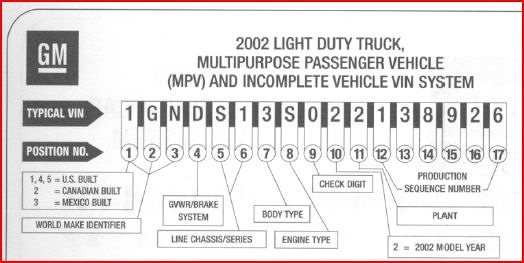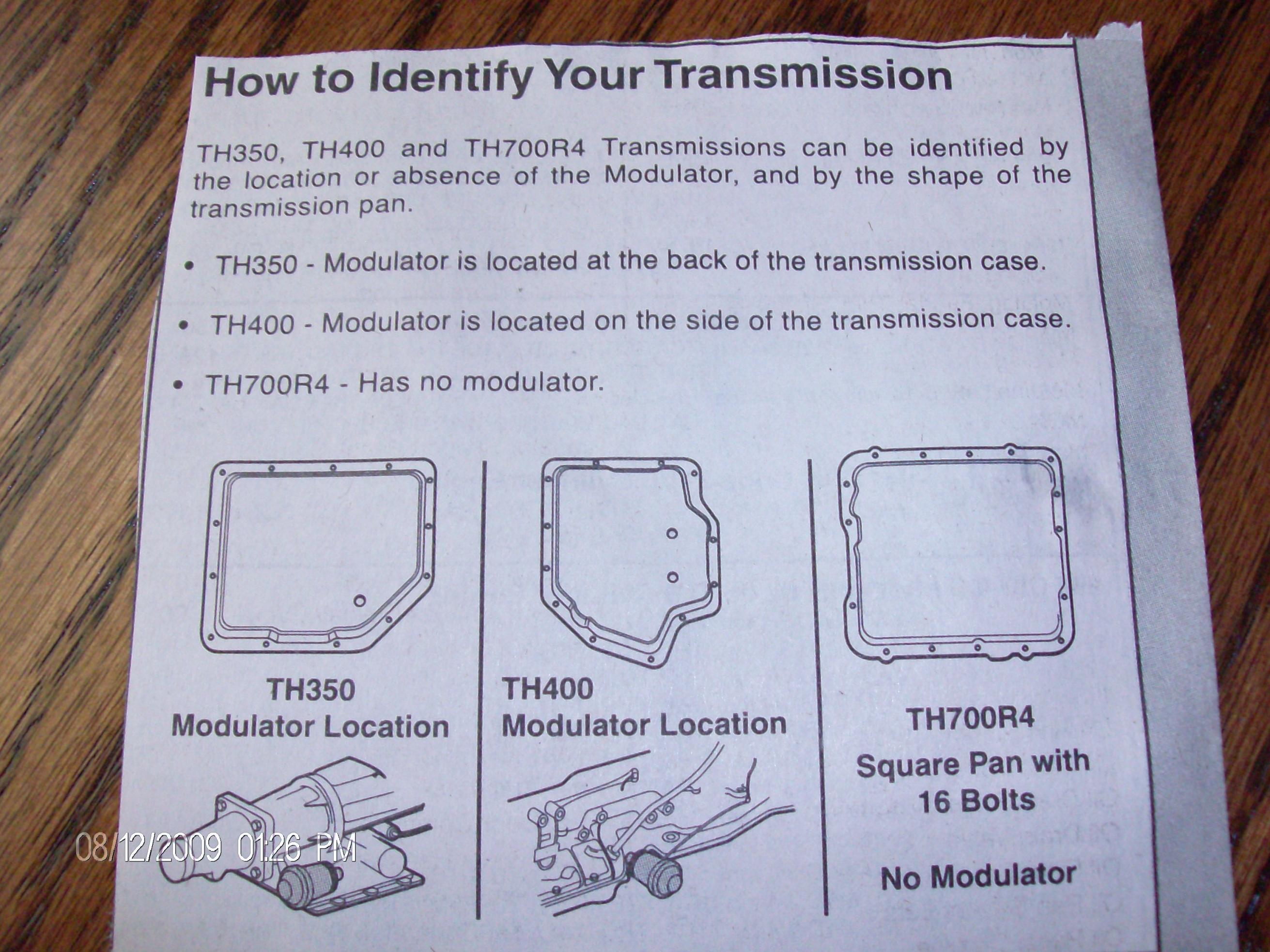Nearly all of the GM automatic transmissions have a few things in common. They are all made of aluminum. The Turbo 350 is arguably GM’s most popular automatic transmission with the aftermarket even today. This is espescially true for the people who are still using the generation I and II small-block Chevy.
Most transmissions originally installed in Chevrolet vehicles from the 1962 model year on should have a VIN or vehicle identification number. The VIN will be located on the top or side of the main case. Most passenger car plants stamped the VIN on the top, while other plants stamped it on the side, near the assembly date code. Quality Reman Transmissions and Transmissions Parts for Ford, Chevy, Dodge, GMC, Jeep, Lincoln, Pontiac Olds and More. Affordable Prices. No Core Charge on Most. Worldwide Shipping. Transmission Depot Has Been Serving Our Local & Online Community for Over 30 Yrs. GM Transmissions: GM Power Glide 2 Speed Transmission. GM Turbo 200 and 200C: 3 Speed Transmission. GM Turbo 2004R (2004R Transmission) Overdrive Transmission. GM Turbo 350 and 350C (TH350 Transmission) 3 Speed Transmission. GM Turbo 400 TH400 Transmission 3 Speed Transmission. GM Transmission Identification Automatic Transmissions. The easiest method of GM automatic transmission identification is to examine the transmission pan. New transmission designs came with new, unique pan shapes, and the general shape of the pan often paints a fairly clear picture of which automatic transmission you are dealing with.
Although the TH350 has been phased out for more than 20 years, you can still find one in the salvage yard. You certainly should not depend on the tech working at the yard for confirmation of what you have. You’ll certainly find them at swap meets and craigslist. Do not depend on someone’s word when they tell you that they have something. I am not saying that people are liars. Most of the time they are not. It’s often the case that the part you are looking at has been sitting around someone’s garage for a long time and they don’t perfectly recall what they have.
There are a few things that all of the longitudinal gm automatic transmissions have in common. They all have basically the same bolt pattern on the bellhousing. Although if you use an older transmission with a newer “LS” engine, you’ll have an extra bolt. But, they do not all bolt into the crossmember in the same space. They are also not the same length. Therefore, they are not all naturally compatible with one another.
[the_ad id=”1070″]
Identifying the TH350 the Easy Way
Certainly the easiest way to identify a GM automatic transmission is by the bolt pattern. The TH350 has a 13 bolt pan gasket. This is a fine way to whittle what you have in front of you. If you counted 13, you are either looking at the Turbo 350 Transmission or the Turbo 400.
You’ll also notice that the pan on the turbo 400 has quite a few more angles than the turbo 350. So, if your pan doesn’t look like a square with a corner taken out than you may want to move along.
Although they aren’t very common, there is a transmission based on the TH35o known as the TH250. It’s visually similar to it’s bigger sibling, but lacks the capability to handle a lot of torque. GM often bolted it behind it’s more anemic six cylinder engines.
It’s gosh darn tough to identify one visually. You’ll need to look above the coolant line fittings to see if there is a threaded screw there. It’s for band adjustment. Most of the info on this site I just know. In this particular case I found that right here:
Using the ID Tag for Identification
Really it is a lot easier to ID a transmission visually compared to the alternative of decoding it, but it is reasonable to try and understand exactly what you have. Now, for the the purpose of this guide there are two different ways that GM printed the the serial label. They changed the way that they labeled their transmissions for the 1967 model year. The TH350 began production in the 1969 model year. That would put it squarely in the second era, and this is how it went.
You’ll need to find the ID tag before you get anywhere. This can be extremely difficult on the TH35o particularly because the ID tag can be found on several different places on the transmission. It can be found on:
- Near where the shift linkage attaches to the body
- Just above the housing on the right side of the pan
- On the passenger side on a flange by the bellhousing
So, you if you are trying to wiggle under a car to read this thing it can be very problematic. You’ll not only need to hunt for this thing, but it needs to be free of enough grime to be legible.
You’ll be looking for these numbers on the ID tag in order to properly tell exactly what kind of transmission that you are dealing with. Most gm transmissions use the M RPO code. Here is a pretty complete list of all of them from the folks over at NastyZ28. The more common ones are:
- MV4- This code identifies your turbo 350 as a “C” model, which had a locking torque converter. This code was used for ten years from 1976 to 1986.
- MX2- Another 350C code. Found on 76-84 models
- MX3- Another Turbo 350C code. 1976-1981 model years.
- MX5- Turbo 350C, 1982 and 1983 only.
- M33- This standard Turbo 350 code identifies it as a standard THM350. This version did not have a locking converter. This one was manufactured from 76-81.
- M38- Standard Turbo 350 manufactured from 1976 to 1981.
General Chevrolet Transmission IdentificationTransmissions are marked and identified by: - Casting numbers on the case, extention housing and side cover Transmissions have RPO numbers, usually beginning with 'M'. |
Chevrolet Automatic Transmission Identification & DescriptionAutomatic transmission types are generally identified by their pan shape. The THM200 and the THM250 have pans shaped like a THM350, HOWEVER, the THM200 will have the words HYDRAMATIC DIV. and METRIC stamped into the pan. Chevy Automatic Transmission Description & Usage THM250 - Used in small 4 cylinder cars (Vega, Sunbird, Monza) from 1973 to 1981 and some Nova/Camaro/Chevelle 6 cylinders in 1974 & 75. The 4 cylinder models have 4 large cooling holes near the torque converter, while on the 'bigger cars' there are no cooling holes. THM200-R4 - Used in GM rear wheel drive cars with the 3.8 V6, 305 & 350 Olds and 301 pontiac from 1981 to 1989. This is a 4 speed, overdrive unit. THM350 - Medium duty 3 speed trans used from 1969 to 1989, Used in Buick, Olds, Pontiac and Chevrolet cars and Chevy & GMC light trucks until 1987. Generally used in straight and V6 and small block engines. Generally able to handle up to 400 foot pounds of torque. THM375B - This trans is identical to the THM350, but is considered a heavier duty transmission. THM375 - This transmission is a derivative of the THM400 sharing the external appearance of the 400. It'll be marked 375-THM on the bottom of the tailshaft housing. It's a light duty version of the THM400, has ABSOLUTELY NO RELATION to the THM375B, and was found in 1972 to 1976 full-size cars. The Turbo 375 was modified to accept the Turbo 350 driveshaft yoke. THM400 - The THM400 was GM's Heavy-duty 3 speed transmission used from 1964 to 1990. Used on large displacement, high torque engines and engines with towing packages. Generally found in Chevy & GM trucks, cadilacs and large displacement engined, full size GM rear wheel drive cars. THM700-R4 - 4 Speed transmission used in GM cars and light trucks with the 2.8, 3.1, 4.3, V6, Chevrolet built 305, 350 and 454 engines from 1982 to 1992. 4L60 - Early 1990's saw the 700R4 renamed to the 4L60, and 'electronic' models were named 4L60E. 4L60 means 4 forward speeds, L = longitudily mounted (rear wheel drive). 60 is the strength rating (less than the 4L80). 3L80 - The 3L80 is a renamed THM400, used in the early 1990's. The 3L80HD would be the THM475 (heavy duty unit). 4L80 - An overdrive model of the THM400. The 4L80E would be the 'electronic' model. Transmissions with a suffix of 'C' on the end of the type (THM200C) indicate the transmission has a lock up torque converter. |
Chevy Automatic Transmission Identification: Other Methods
Some transmissions have a code stamped onto them. Others have a tag rivited to the case.
Chevy Transmission Lookup By Vin
Most transmissions will have a 'source serial number' (chassis vin) usually found close to the transmission code. This number will contain division ID #, model year, assembly plant and production sequence (last 6 digits) of the VIN stamped onto the transmission. Example: 19N500001. The source serial number is from the CAR the transmission originally went into, NOT the assembly plant.
Location of source serial number

On the THM350, the VIN will be stamped on either the drivers side housing near the shifter, on the right side of the housing just above the pan, or on a boss behind the bellhousing flange on the passenger side of the transmission.
On the THM400 the VIN is stamped on a machined surface just above the pan on the drivers side.
On the THM200-R4 the VIN is stamped onto the housing towards the rear of the pan, on the drivers side.
On the THM700-R4 the VIN is either stamped onto a boss behind the bellhousing flange on the passenger side, just above the pan on the drivers side, or just behind the governor cover, stamped vertically where the case meets the tailshaft housing.

Prior to 1967, transmission ID numbers contained the plant prefix code, month and date of production (expressed numerically) and a shift code (D = Day, N = Night). From 1967 on, the ID number contained the transmission type or plant prefix, Date (coded below) and a shift code. The constants in decoding the trans ID number are the date the transmission was produced.
Chevy Transmission Identification By Vin Number
Pre-67 Example: C213N - (C = Cleveland Powerglide, February 13, Night Shift)
Post-67 Example: P9E03 - (P = TYPE, 9 = year (1969), E = Month, 03 = Day of Month)
Chevy Transmission Identification By Vin Tag
Month code: (NOTICE this is NOT in alphabetic order)
A = Jan, B = Feb, C = Mar, D = Apr, E = May, H = Jun, K = Jul, M = Aug, P = Sep, R = Oct, S = Nov, T = Dec
How To Identify Transmission By Vin Number
The latest posts on transmissions from the NastyZ28 message board. Please join in the discussion by registering here.
How To Identify Transmission By Vin
Chevy Manual Transmission Identification
Author: MadMike Maciolek
North Georgia Classic Camaro All rights reserved |
